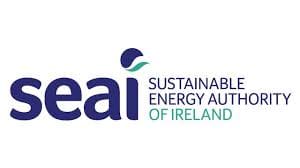Business Supports From The SEAI

Your customers expect to see that your business is taking steps towards sustainability. Improving the energy efficiency of your business is the best place to start.
The Sustainable Energy Authority of Ireland provides grants and supports to help your business cut down on energy costs, reduce your energy use and decarbonise your operations.
SEAI simple steps to start your business energy efficiency journey:
Step 1. Understand your energy use + link to Steps To Energy Efficiency For Your SME | Business | SEAI
Step 2. Create an energy action plan + link to Steps To Energy Efficiency For Your SME | Business | SEAI
Step 3. Complete an energy audit + link to Steps To Energy Efficiency For Your SME | Business | SEAI
Step 4. Invest in energy efficiency upgrades and renewables + link to Steps To Energy Efficiency For Your SME | Business | SEAI
Step 5. Monitor, track and report + link to Steps To Energy Efficiency For Your SME | Business | SEAI
SEAI Supports & Resources
- Encourage your staff to join the SEAI Energy Academy – free, on-demand energy training created by energy experts – where they will learn about the basics of energy efficiency, in modules such as ‘Electricity Bill Analysis’, ‘Introduction to Solar PV’ or ‘Heating Energy Analysis’, helping you to embed a sustainable energy use culture within your organization
- Sign up for SEAI’s free monthly Introduction to Energy Management Workshops here to learn how to start tracking your energy use and create an energy action plan
- If you spend more than €10k per annum on energy, apply for the SEAI Support Scheme for Energy Audits and receive a €2,000 voucher towards a high-quality energy audit. This will help you identify your significant energy users and steps you can take to reduce your energy use.
- Share SEAI’s Reduce your use booklet with your team and customers
- Watch SEAI’s Business Briefing to learn about all the grants & supports available for companies here SEAI Business Briefing – Steps to a Low Carbon Business
- Read SEAI blog on ‘Reducing electrical demand during peak hours: smart solutions for Irish businesses’
SEAI tips for SMEs on how to reduce your energy costs
War and conflict are affecting energy prices right across Europe. By reducing our energy use at work, we can limit our reliance on expensive, imported fossil fuels. Working with businesses, SEAI understands the impact of rising energy costs and the need to reduce your energy use and save money.
An average SME could potentially reduce its energy bills by up to 30%, by implementing energy efficiency measures; 10% savings can be achieved with little or no capital cost. Here are some key actions that your business and employees can take now to get winter ready and become more resilient to rising energy costs.
Heating
The longer your heating is on and the higher your thermostat is set, the higher your bills will be. Remember heating costs increase by 8% for every 1-degree increase.
- Check your timers are set to the correct date and time considering different working hours on the weekends and bank holidays
- Ensure your heating in offices is set to 19 degrees and in areas of higher physical activity set to below 19 degrees
- Identify who is responsible for heating controls and communicate this to your employees, asking that they avoid tampering with the controls
Draughts
Up to 30% of heating costs can be saved by preventing cold air entering a building. So, controlling this is one of the easiest ways to reduce your heating energy bills.
- Ensure staff are aware of the cost of wasted heat
- Identify sources of draughts and fit appropriate draught proofing. Think about seals around doors and windows, do they need maintenance?
- Ensure that doors are not being propped open for convenience and consider fitting spring-loaded door closures
Lighting
For many businesses lighting is one of the most energy intensive parts of the business and can be responsible for 40% of a building’s electricity use.
- Make use of natural light, relocate objects that are blocking windows, ensure window blinds are open during the day and arrange desks near windows without causing glare
- Identify and label your lighting switches to encourage staff to turn them off when not in use and agree with your employees that the last one out turns the lights off
- Consider installing occupancy sensors which can reduce lighting energy use by 30%
- LED lamps use up to 90% less energy than traditional lamps and can last up to five times longer. Consider replacing existing non-LED lamps with suitable LED ones.


